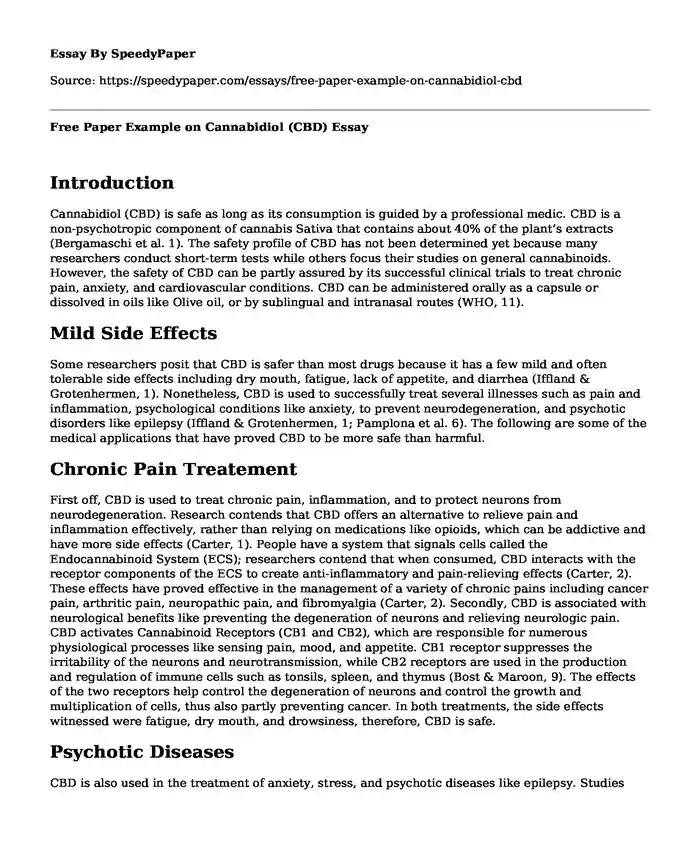Introduction
Cannabidiol (CBD) is safe as long as its consumption is guided by a professional medic. CBD is a non-psychotropic component of cannabis Sativa that contains about 40% of the plant’s extracts (Bergamaschi et al. 1). The safety profile of CBD has not been determined yet because many researchers conduct short-term tests while others focus their studies on general cannabinoids. However, the safety of CBD can be partly assured by its successful clinical trials to treat chronic pain, anxiety, and cardiovascular conditions. CBD can be administered orally as a capsule or dissolved in oils like Olive oil, or by sublingual and intranasal routes (WHO, 11).
Mild Side Effects
Some researchers posit that CBD is safer than most drugs because it has a few mild and often tolerable side effects including dry mouth, fatigue, lack of appetite, and diarrhea (Iffland & Grotenhermen, 1). Nonetheless, CBD is used to successfully treat several illnesses such as pain and inflammation, psychological conditions like anxiety, to prevent neurodegeneration, and psychotic disorders like epilepsy (Iffland & Grotenhermen, 1; Pamplona et al. 6). The following are some of the medical applications that have proved CBD to be more safe than harmful.
Chronic Pain Treatement
First off, CBD is used to treat chronic pain, inflammation, and to protect neurons from neurodegeneration. Research contends that CBD offers an alternative to relieve pain and inflammation effectively, rather than relying on medications like opioids, which can be addictive and have more side effects (Carter, 1). People have a system that signals cells called the Endocannabinoid System (ECS); researchers contend that when consumed, CBD interacts with the receptor components of the ECS to create anti-inflammatory and pain-relieving effects (Carter, 2). These effects have proved effective in the management of a variety of chronic pains including cancer pain, arthritic pain, neuropathic pain, and fibromyalgia (Carter, 2). Secondly, CBD is associated with neurological benefits like preventing the degeneration of neurons and relieving neurologic pain. CBD activates Cannabinoid Receptors (CB1 and CB2), which are responsible for numerous physiological processes like sensing pain, mood, and appetite. CB1 receptor suppresses the irritability of the neurons and neurotransmission, while CB2 receptors are used in the production and regulation of immune cells such as tonsils, spleen, and thymus (Bost & Maroon, 9). The effects of the two receptors help control the degeneration of neurons and control the growth and multiplication of cells, thus also partly preventing cancer. In both treatments, the side effects witnessed were fatigue, dry mouth, and drowsiness, therefore, CBD is safe.
Psychotic Diseases
CBD is also used in the treatment of anxiety, stress, and psychotic diseases like epilepsy. Studies affirm that CBD can be used to treat psychological conditions like stress, anxiety, and lack of sleep. CBD contains high levels of terpenes, compounds responsible for scents in plants that also have physiological effects. The interaction between CBD and terpenes results in a synergistic action that enables terpenes to increase the permeability of the blood-brain barrier and interact with neuro-receptors to produce analgesic and psychotic effects (Gloria et al. 290). These effects relieve pain and alleviate the anxiety and stress of the user. Moreover, CBD is used to treat epilepsy and control seizures. Results from 11 studies revealed that CBD treatment enhances the control of seizure in patients with treatment-resistant epilepsy. In all the studies, 60% of the patients noted clinical improvement and 40% reported at least a 50% decrease in the frequency of seizures (Pamplona et al. 6).
Conclusion
Thus, CBD has wide medical applications and minimal mild side effects, therefore, CBD is safe for use and it is recommendable for medical professionals to invent more of its beneficial applications. However, this topic has less literature and more research should be conducted to develop the safety profile of CBD.
Work Cited
Carter, A. “Using CBD oil for pain management: Does it work?” Healthline.
https://www.healthline.com/health/cbd-oil-for-pain
Gloria, Elanne Costa, et al. "Biological properties and therapeutic applications of cannabidiol." Journal of Medicinal Plants Research 14.6 (2020): 283-291.
https://academicjournals.org/journal/JMPR/article-full-text-pdf/1690A3D63559
Iffland, Kerstin, and Franjo Grotenhermen. "An update on safety and side effects of cannabidiol: a review of clinical data and relevant animal studies." Cannabis and cannabinoid research 2.1 (2017): 139-154. https://www.ncbi.nlm.nih.gov/pmc/articles/PMC5569602/
Machado Bergamaschi, Mateus, et al. "Safety and side effects of cannabidiol, a Cannabis sativa constituent." Current drug safety 6.4 (2011): 237-249. https://www.researchgate.net/profile/Regina_Queiroz/publication/51841989_Safety_and_Side_Effects_of_Cannabidiol_a_Cannabis_sativa_Constituent/links/53d687ff0cf228d363ea614d.pdf
Maroon, Joseph, and Jeff Bost. "Review of the neurological benefits of phytocannabinoids." Surgical neurology international 9 (2018).
https://www.ncbi.nlm.nih.gov/pmc/articles/PMC5938896/
Pamplona, Fabricio A., Lorenzo Rolim da Silva, and Ana Carolina Coan. "Potential clinical benefits of CBD-rich cannabis extracts over purified CBD in treatment-resistant epilepsy: observational data meta-analysis." Frontiers in neurology 9 (2018): 759.
https://www.ncbi.nlm.nih.gov/pmc/articles/PMC6143706/
World Health Organization. “Cannabidiol (CBD) critical review report. WHO (2018).” https://www.who.int/medicines/access/controlled-substances/CannabidiolCriticalReview.pdf.
Cite this page
Free Paper Example on Cannabidiol (CBD). (2023, Nov 24). Retrieved from https://speedypaper.net/essays/free-paper-example-on-cannabidiol-cbd
Request Removal
If you are the original author of this essay and no longer wish to have it published on the SpeedyPaper website, please click below to request its removal:
- The Man Flu Essay Samples
- Medicine Essay Sample: Asthma and Stepwise Management
- Essay Example - Gaucher Disease
- Paper Example. Alzheimer's Disease International Care Home
- Essay Sample: Operations Management Forum
- Free Essay. Schizophrenia as a Psychological Disorder
- Pathophysiology of Parkinson's Disease - Essay Sample
Popular categories





